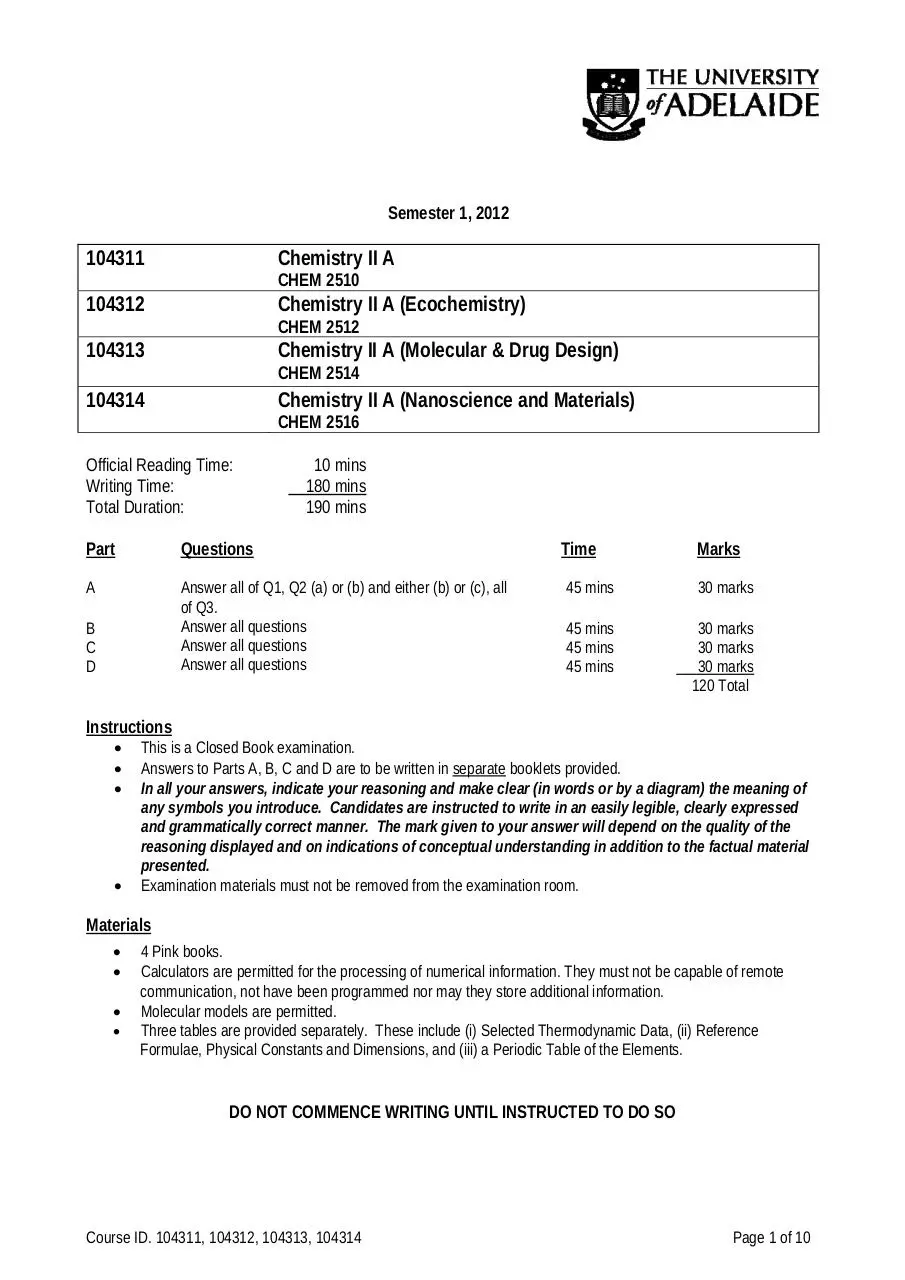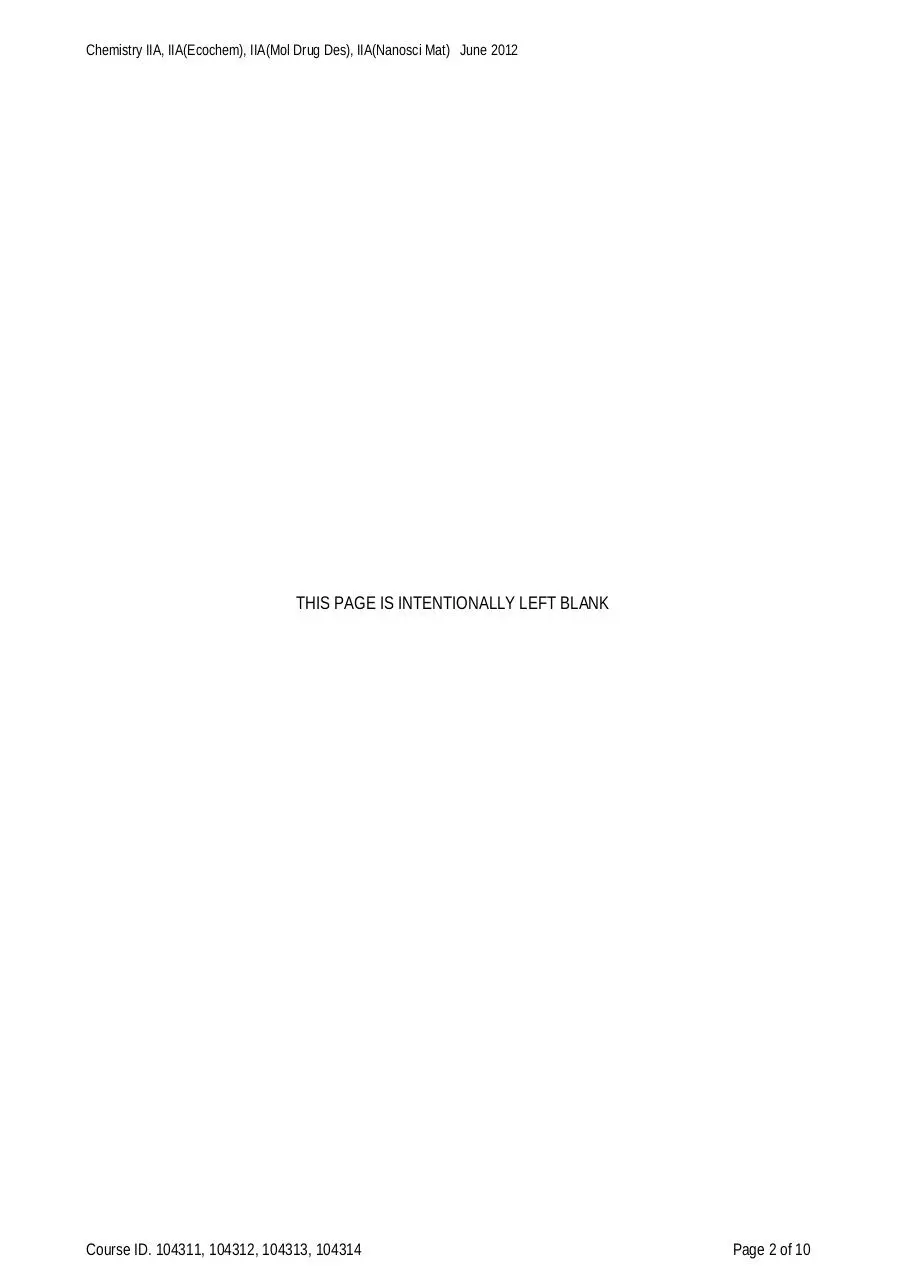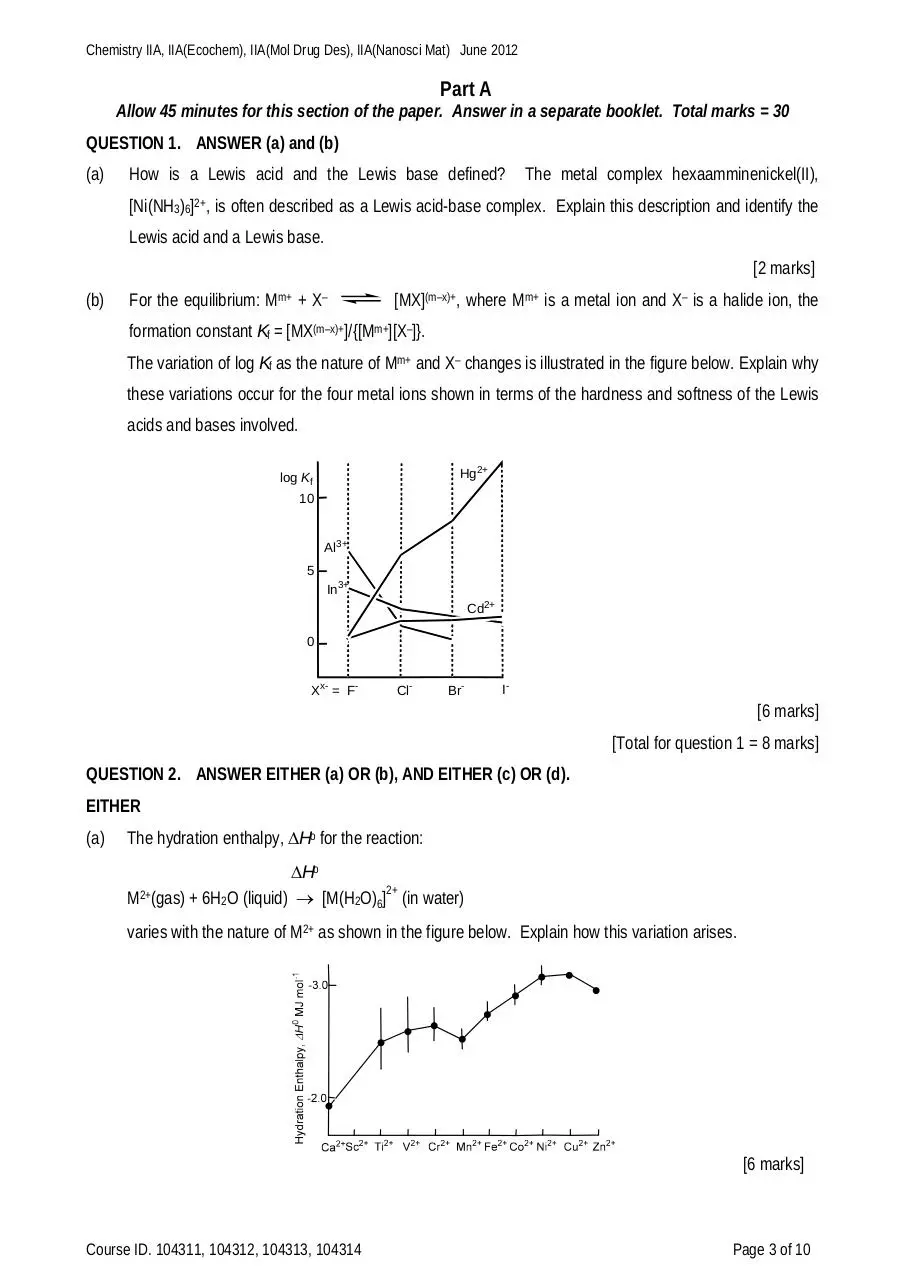ChemIIA 2012 final (PDF)
File information
Title: Microsoft Word - ChemIIA 2012 Not for Pub working.doc
Author: a1087934
This PDF 1.6 document has been generated by PScript5.dll Version 5.2.2 / Acrobat Distiller 9.0.0 (Windows), and has been sent on pdf-archive.com on 23/06/2014 at 14:23, from IP address 203.122.x.x.
The current document download page has been viewed 1100 times.
File size: 245.81 KB (17 pages).
Privacy: public file





File preview
Semester 1, 2012
104311
Chemistry II A
104312
Chemistry II A (Ecochemistry)
CHEM 2510
CHEM 2512
104313
Chemistry II A (Molecular & Drug Design)
CHEM 2514
104314
Chemistry II A (Nanoscience and Materials)
CHEM 2516
Official Reading Time:
Writing Time:
Total Duration:
10 mins
180 mins
190 mins
Part
Questions
Time
Marks
A
Answer all of Q1, Q2 (a) or (b) and either (b) or (c), all
of Q3.
Answer all questions
Answer all questions
Answer all questions
45 mins
30 marks
45 mins
45 mins
45 mins
30 marks
30 marks
30 marks
120 Total
B
C
D
Instructions
This is a Closed Book examination.
Answers to Parts A, B, C and D are to be written in separate booklets provided.
In all your answers, indicate your reasoning and make clear (in words or by a diagram) the meaning of
any symbols you introduce. Candidates are instructed to write in an easily legible, clearly expressed
and grammatically correct manner. The mark given to your answer will depend on the quality of the
reasoning displayed and on indications of conceptual understanding in addition to the factual material
presented.
Examination materials must not be removed from the examination room.
Materials
4 Pink books.
Calculators are permitted for the processing of numerical information. They must not be capable of remote
communication, not have been programmed nor may they store additional information.
Molecular models are permitted.
Three tables are provided separately. These include (i) Selected Thermodynamic Data, (ii) Reference
Formulae, Physical Constants and Dimensions, and (iii) a Periodic Table of the Elements.
DO NOT COMMENCE WRITING UNTIL INSTRUCTED TO DO SO
Course ID. 104311, 104312, 104313, 104314
Page 1 of 10
Chemistry IIA, IIA(Ecochem), IIA(Mol Drug Des), IIA(Nanosci Mat) June 2012
THIS PAGE IS INTENTIONALLY LEFT BLANK
Course ID. 104311, 104312, 104313, 104314
Page 2 of 10
Chemistry IIA, IIA(Ecochem), IIA(Mol Drug Des), IIA(Nanosci Mat) June 2012
Part A
Allow 45 minutes for this section of the paper. Answer in a separate booklet. Total marks = 30
QUESTION 1. ANSWER (a) and (b)
(a)
How is a Lewis acid and the Lewis base defined?
The metal complex hexaamminenickel(II),
[Ni(NH3)6]2+, is often described as a Lewis acid-base complex. Explain this description and identify the
Lewis acid and a Lewis base.
[2 marks]
(b)
For the equilibrium: Mm+ + X–
[MX](m–x)+, where Mm+ is a metal ion and X– is a halide ion, the
formation constant Kf = [MX(m–x)+]/{[Mm+][X–]}.
The variation of log Kf as the nature of Mm+ and X– changes is illustrated in the figure below. Explain why
these variations occur for the four metal ions shown in terms of the hardness and softness of the Lewis
acids and bases involved.
Hg2+
log Kf
10
Al3+
5
In3+
Cd2+
0
Xx- = F-
Cl-
Br-
I-
[6 marks]
[Total for question 1 = 8 marks]
QUESTION 2. ANSWER EITHER (a) OR (b), AND EITHER (c) OR (d).
EITHER
(a)
The hydration enthalpy, Ho for the reaction:
Ho
M2+(gas) + 6H2O (liquid) [M(H2O)6]2+ (in water)
varies with the nature of M2+ as shown in the figure below. Explain how this variation arises.
[6 marks]
Course ID. 104311, 104312, 104313, 104314
Page 3 of 10
Chemistry IIA, IIA(Ecochem), IIA(Mol Drug Des), IIA(Nanosci Mat) June 2012
OR
(b)
The molecular orbitals of octahedral first row d-metal complexes [ML6] (in which there is no bonding)
have the following order of descending energy: t1u > a1g > eg > t2g > eg > t1u > a1g.
Construct a molecular orbital energy level diagram showing the energies of the molecular orbitals of the
complex [ML6] and the energies and identities of the metal and ligand orbitals from which they were
formed. Identify the molecular orbitals of the complex as antibonding, nonbonding and bonding.
Identify the LUMO and HOMO molecular orbitals of the complex. Indicate the ligand field splitting,o,
on your molecular orbital energy level diagram.
[6 marks]
AND
EITHER
(c)
The complex [Ir(Cl)3(PPh3)3] exists as two geometric isomers (PPh3 is triphenylphosphine). Draw and
name these isomers. One isomer possesses a C2 axis of symmetry and the other a C3 axis of
symmetry. Show these axes on your drawings of the isomers and explain what the symbols C2 and C3
signify.
[4 marks]
OR
(d)
The complex [Cr(ox)3]3- (where ox2- is oxalate, -O2C-CO2-) exists as two enantiomers. Name them, draw them
and explain their relationship to each other. Each enantiomer possesses a C3 axis of symmetry. Show this C3
axis on the drawings of each of the enantiomers and explain what the symbol C3 signifies.
[4 marks]
[Total for question 2 = 10 marks]
QUESTION 3. ANSWER (a), (b) and (c).
(a)
Draw the catalytic scheme for the Monsanto synthesis of acetic acid from methanol using the
[RhI2(CO)2] catalyst in the presence of CO. Identify the oxidative addition step and the reductive
elimination step. Explain why [RhI2(CO)2] is described as a 16 electron system.
[6 marks]
(b)
Describe with an annotated drawing the structure of methyllithium. Methyllithium is electron deficient.
Explain this in terms of the valence electrons available and the type of bonding present.
[3 marks]
(c)
Describe with an annotated drawing the structure of trimethylaluminium. Trimethylaluminium is electron
deficient. Explain this in terms of the valence electrons available and the type of bonding present.
[3 marks]
[Total for question 3 = 12 marks]
[Total for Part A = 30 marks]
- - - END of PART A - - -
Course ID. 104311, 104312, 104313, 104314
Page 4 of 10
Chemistry IIA, IIA(Ecochem), IIA(Mol Drug Des), IIA(Nanosci Mat) June 2012
Part B
Allow 45 minutes for this section of the paper. Answer in a separate booklet. Total marks = 30
QUESTION 1
(a)
Calculate the entropy change for burning 1 kg of n-octane(g) to H2O(l) and CO2(g) at 298 K and 1 atm.
[3 marks]
(b)
One mole of an ideal monatomic gas is expanded from an initial state of 2 atm and 400 K to a final state
of 1 atm and 300 K. Calculate S for the following paths:
Isothermal expansion against 1 atm at 400 K, followed by an isobaric decrease in T to 300 K.
[5 marks]
[Total for question 1 = 8 marks]
QUESTION 2
(a)
Calculate the work done at 298.15 K when 1 mole of an ideal gas expands isothermally from 400 kNm-2
to 150 kNm-2 in one stage by a sudden direct reduction in pressure to 150 kNm-2.
[2 marks]
(b)
Calculate the work done at 298.15 K when 1 mole of an ideal gas expands isothermally by having a
large series of infinitesimal decreases of pressure over a long period from 400 kNm-2 to 150 kNm-2.
[2 marks]
[Total for question 2 = 4 marks]
QUESTION 3
(a)
One mole of an ideal monatomic gas is expanded from an initial state of 4 atm and 300 K to a final state
of 2 atm and 300 K. Calculate G for this expansion.
[3 marks]
(b)
Using the thermodynamic information provided, determine which set of products will be most favoured?
Show your work clearly to receive full credit.
H 2O2 ( g )
2OH ( g ) H 2O( g ) 0.5O2 ( g )
OH ( g ) OH ( g )
H2O(g)
H2O2 (g)
OH(g)
OH-(g)
OH+(g)
O2(g)
(a)
(b)
(c )
Gof(298 K) kJmol-1
-228.572
-105.57
34.23
-138.698
1306.437
0
[5 marks]
[Total for question 3 = 8 marks]
Course ID. 104311, 104312, 104313, 104314
Page 5 of 10
Chemistry IIA, IIA(Ecochem), IIA(Mol Drug Des), IIA(Nanosci Mat) June 2012
QUESTION 4
The natural logarithm of the rate constant (ln k) is plotted against the reciprocal of the absolute temperature for
the decomposition of N2O. The best-fit linear curve has an equation shown below in the plot.
4
ln k
2
0
0.0008
0.001
0.0012
-2
y = -30317x + 29.346
-4
-6
-8
-1
1/T (K )
What is the value of the activation energy of this reaction?
[Total for question 4 = 3 marks]
QUESTION 5
(a)
Briefly explain why the following rate law for the chemical reaction below is unlikely.
2NO2(g) + F2(g) 2NO2F(g)
Rate = k[NO2]2[F2], where k is the rate constant
[1 mark]
(b)
In fact, the experimentally determined rate law for the reaction is Rate = k[NO2][F2]. Propose a simple
and acceptable mechanism that satisfies the rate law.
[2 marks]
[Total for question 5 = 3 marks]
QUESTION 6
The decomposition of hydrogen iodide,
2HI(g) H2(g) + I2(g)
has rate constants of 9.51 x 10-9 L/mols at 500 K and 1.10 x 10-5 L/mols at 600 K. Calculate the activation
energy. Hint: the frequency factor A is independent of temperature.
[Total for question 6 = 4 marks]
[Total for Part B = 30 marks]
- - - END of PART B - - -
Course ID. 104311, 104312, 104313, 104314
Page 6 of 10
Chemistry IIA, IIA(Ecochem), IIA(Mol Drug Des), IIA(Nanosci Mat) June 2012
Part C
Allow 45 minutes for this section of the paper. Answer in a separate booklet. Total marks = 30
QUESTION 1
The following wedge-and-dash structure illustrates a conformation for one of the stereoisomers of 1,2dibromo-1,2-diphenylethane.
H
Br
Ph H
Ph
Br
(a)
Assign the configuration of the stereocentre(s) as either R or S.
(b)
Draw a Newman projection, viewed along the bond between C1 and C2, for this conformation.
(c)
Draw the wedge-and-dash structure that illustrates the conformation where the bromo groups are
antiperiplanar.
(d)
Is this compound optically active? Provide a reason for your answer.
[Total for question 1 = 6 marks]
QUESTION 2
For the following reactions, draw the major product(s). If the products can exist as stereoisomers, show which
stereoisomers are obtained. Also indicate whether the final product(s) for each reaction is/are chiral.
a)
(a)
Br
HBr
Ph
(b)
b)
CH3
H3C
O
CH3
1. PhMgBr
2. H+ / H2O
[Total for question 2 = 6 marks]
QUESTION 3
For each of the following molecules:
H3C
HO
Br
Br
(a)
draw clear chair conformation structures.
(b)
draw the alternate (ring-flipped) chair conformation for each compound.
(c)
circle the chair conformation that you predict to be the more stable for each compound. Provide a
reason for your decision in each case.
[Total for question 3 = 6 marks]
Course ID. 104311, 104312, 104313, 104314
Page 7 of 10
Chemistry IIA, IIA(Ecochem), IIA(Mol Drug Des), IIA(Nanosci Mat) June 2012
QUESTION 4
(a)
By considering the reagents and conditions for each reaction below, determine if a substitution
reaction would proceed. If yes, give a detailed mechanism for the formation of all possible products,
clearly showing stereochemistry where applicable.
(i)
H3C
Br
NaCN
DMSO
[3 marks]
(ii)
Br
Ph
Ph
(b)
CH3
H2O
[3 marks]
Two alkenes are formed from the E1 reaction of bromide X. Draw the structures of these alkenes,
indicate which one would be the major product and provide a reason for your choice.
Br
H3C
Ph
CH3
X
[4 marks]
(c)
The molecule below contains two halogens. Which halogen would be more reactive in an SN1
reaction? Provide a reason for your answer.
Cl
Cl
[2 marks]
[Total for question 5 = 12 marks]
[Total for Part C = 30 marks]
- - - END of PART C - - -
Course ID. 104311, 104312, 104313, 104314
Page 8 of 10
Chemistry IIA, IIA(Ecochem), IIA(Mol Drug Des), IIA(Nanosci Mat) June 2012
Part D
Allow 45 minutes for this section of the paper. Answer in a separate booklet. Total marks = 30
QUESTION 1
In each reaction below, identify the product(s) formed and give a detailed mechanism for their formation
(a)
O
1. SOCl2
OH
2. MeNH2
[3 marks]
(b)
O
1. HO
CO2Me
OH
H+
2. MeMgBr
3. H+ / H2O
[5 marks]
[Total for question 1 = 8 marks]
QUESTION 2
Answer questions (a) to (d) given the following information
X
Ph
Br
Ph
A
OMe
Y
Ph
(a)
Draw two chair conformations for A.
(b)
Suggest reagents and conditions for X and Y, with detailed reasons.
[2 marks]
[4 marks]
(c)
Give detailed mechanisms for each reaction, with reference to your structures in part (a).
[4 marks]
(d)
Suggest a competing reaction for step Y.
[1 mark]
[Total for question 2 = 11 marks]
Course ID. 104311, 104312, 104313, 104314
Page 9 of 10
Download ChemIIA 2012 final
ChemIIA 2012 final.pdf (PDF, 245.81 KB)
Download PDF
Share this file on social networks
Link to this page
Permanent link
Use the permanent link to the download page to share your document on Facebook, Twitter, LinkedIn, or directly with a contact by e-Mail, Messenger, Whatsapp, Line..
Short link
Use the short link to share your document on Twitter or by text message (SMS)
HTML Code
Copy the following HTML code to share your document on a Website or Blog
QR Code to this page

This file has been shared publicly by a user of PDF Archive.
Document ID: 0000170412.